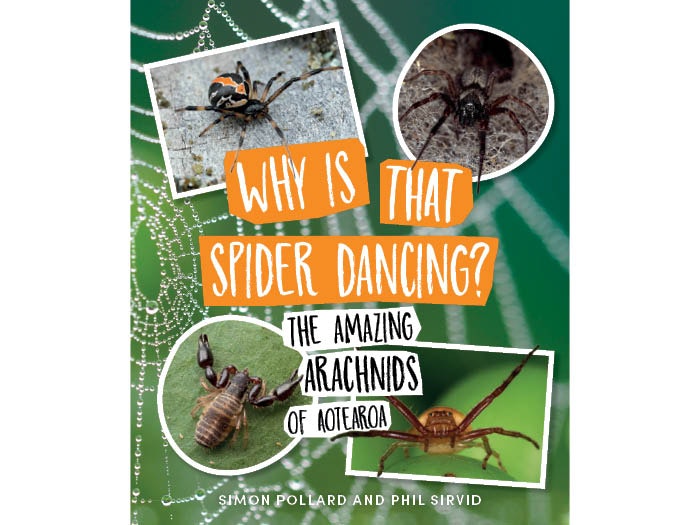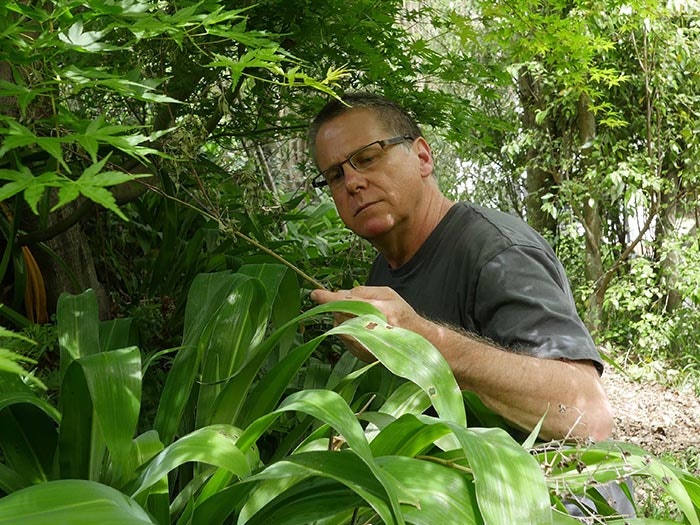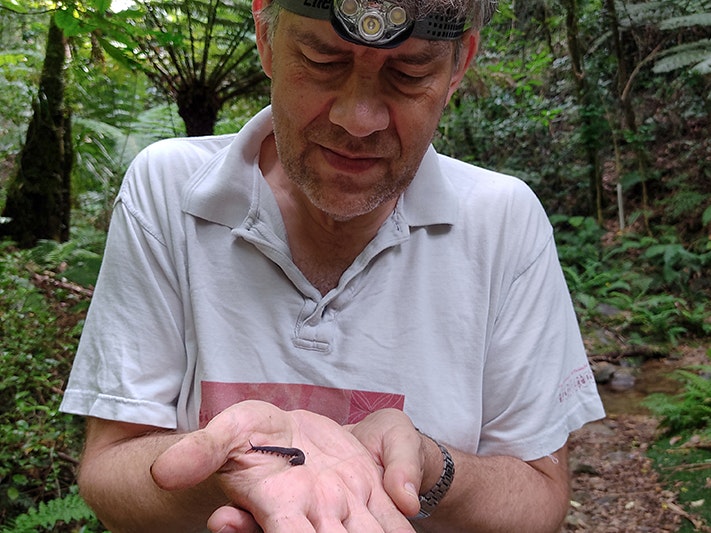
Why is That Spider Dancing? The Amazing Arachnids of Aotearoa
A fun, fascinating and revealing book about Aotearoa’s amazing eight-legged marvels
Free museum entry for New Zealanders and people living in New Zealand
Open every day 10am-6pm
(except Christmas Day)
Free museum entry for New Zealanders and people living in New Zealand
Simon Pollard and Phil Sirvid discuss Why is That Spider Dancing? The Amazing Arachnids of Aotearoa with Te Papa Press.
Dr Simon Pollard is a spider biologist and award-winning natural history photographer and writer. He has written and illustrated a number of children’s books in New Zealand and the United States and has twice won the LIANZA Elsie Locke non-fiction book of the year. His last two books, both published by Te Papa Press, are Why Is That Lake So Blue? (2018) and The Genius of Bugs (2017), which was shortlisted for the New Zealand Book Awards for Children and Young Adults. Simon has also been an advisor, scriptwriter and presenter on a number of natural history documentaries, including the BBC’s Planet Earth. In 2007 he was awarded theNew Zealand Association of Scientists’ Science Communicator of the Year Award. Since 2009, Simon has been Adjunct Professor of Science Communication at the University of Canterbury.
Dr Philip Sirvid is Assistant Curator in the Natural History Team at Te Papa. Phil has a broad general knowledge of New Zealand entomology but specialises in the arachnids, particularly spiders and harvestmen. He has published on the taxonomy, systematics and evolutionary history of New Zealand spiders as well as on medical entomology and arachnid conservation. Phil has been involved in science outreach at Te Papa for many years and contributed to 100 Natural History Treasures of Te Papa, and Nature—Stilled, both published by Te Papa Press.
PS: We met back in the late 1990s when Simon was working on various spider research projects in Aotearoa and overseas. More recently, we both worked on Te Papa’s exhibition Bug Lab. We enjoyed working together so much we decided we wanted to write a book on Aotearoa’s arachnids. And fortunately with the wonderful team at Te Papa Press, we have.
SP: Why is That Lake So Blue? was much broader in its scope as it covered all the topics around Aotearoa’s natural world, like geography, geology, biodiversity and conservation. This book, however, is focused on a group with which Phil and I are both familiar so it was a lot of fun to come up with the arachnids we wanted to include in the book and then to bring them to life by writing about their incredible lives. Who would have thought we have a spider in Aotearoa that can survive in its silken nest under the sea for almost three weeks!
PS: When I was four, a big black tunnelweb spider crawled up my leg and gave me nightmares! However, when I was in my early teens I saw a garden orbweb spider catching a very angry German wasp that was trying to sting it. The way the spider ran rings around the wasp as it wrapped it in silk impressed me a lot. When I got to university I discovered the work of Ray Forster, and that opened my eyes to how special our arachnids are. I’ve gone from being an arachnophobe to an arachnophile for sure.
PS: I want readers to understand that most of the arachnids we have here are as unique to Aotearoa as iconic species like kiwi and tuatara.
SP: I hope this book helps people appreciate the arachnids of Aotearoa as animals that should be admired rather than feared. Think of them as kiwi and tuatara ambassadors for Aotearoa – they just happen to be tiny and have eight legs!
PS: I think Opiliones (harvestmen) are very underappreciated. Most people have never heard of them, but we have a rich fauna, with all but two of our species only found here and nowhere else on Earth. So many of them just look wonderfully bizarre too.
SP: I think jumping spiders. They are found everywhere in Aotearoa from high in the Southern Alps to our coastlines. They have excellent eyesight and are clever, almost like a small mammal. The Chinese call them ‘fly tigers’ because they hunt flies like a tiger hunts prey. Scientists call them eight-legged cats. Look into the big front eyes of a fly tiger and it will probably look back at you. It is an amazing animal seen commonly on our window sills – we share our homes with a brainy spider!
SP: We share this country with a wonderfully rich arachnid fauna mostly found nowhere else. Let them live in your backyards and on your houses. Don’t spray them with chemicals as if they were pests – they are not and are essential for keeping us from being knee-deep in insects. Plus, what a bonus to have so many fascinating animals living enthralling lives in the garden and at home! Let them be, but peer into their lives without harming them.
SP: You need to be able to make small animals appear big by having specialised close-up camera equipment. Then you can photograph their lives, and take interesting photographs, just as if they were much bigger animals. I often imagine myself as a tiny photographer being able to take their photographs, without being eaten, as I move through their world and their daily lives – a bit like a street photographer, but photographing spiders rather than people.
PS: It’s hard to be exactly sure, but it’s likely to be over 20,000 specimen lots. It’s not that exciting to look at as it consists of jars full of tubes of ethanol-preserved specimens. The real magic happens when you take a specimen out of a tube and start looking at it under the microscope.
PS: I think Aragog from Harry Potter is more realistic looking, but Shelob from The Lord of the Rings is the more menacing spider. Shelob is also based in part on our very own black tunnelweb spider, so I’m voting for her!
SP: She may be only life-size, but I think Charlotte from Charlotte’s Web deserves a mention. After all, with her compassion, she saved the life of a pig by writing messages in her web. And that’s a spider story with a happy ending that generations have been touched by.
PS: We still have lots of species to find, document and name. Even for those species we've already named, we don’t have much idea of how they live their lives at all. We’ll never run out of things to discover.
SP: So much of what we learn about these tiny creatures comes from having technology to see them in ways we could not in the past. For example, to see how fast the rice-grain-sized trap-jaw spider shuts its jaws required a high-speed video camera shooting at 40,000 frames a second. To our eyes it’s just a blur. I’m sure we will continue to be surprised at what these animals are capable of, as technology allows us to see more of the details of what makes them tick.

A fun, fascinating and revealing book about Aotearoa’s amazing eight-legged marvels

